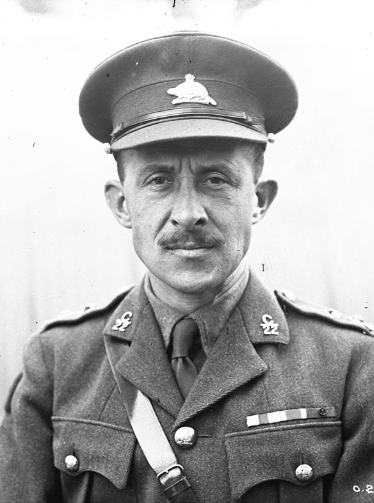
1886 - 1951
Born in Chicoutimi, Thomas-Louis Tremblay was raised and educated in Quebec and was strongly influenced by the social environment that existed at the time. Canadian institutions of the day, including the armed forces, largely did not reflect the character of both founding peoples and very few French Canadians considered a career in the Anglophone-dominated army. Nevertheless, he was attracted to the military life, joined the Artillery (militia) at the age of fifteen and enrolled at RMC in 1904, one of only nineteen French Canadians who attended the college between 1900 and 1914. He graduated in 1907 with a diploma in engineering and in his final year he won the “Best Man at all Arms” award and the Lt.-Col. Ernest F. Wurtele Gymnastic Shield as the best gymnast in his class.
When the First World War broke out in 1914, Tremblay very quickly joined the ranks of a great number from Quebec who chose to serve Canada despite the social barriers. He was named Commanding Officer of the 22nd Battalion (French Canadian) in early 1916 and went on to lead them to triumph at Courcelette, a victory of great importance and a defining moment in the unit's history.
Returning from medical leave in February 1917, the battalion that Tremblay found was not at all the same as the one he had nurtured and led during the Somme offensive, largely due to extraordinary losses at all rank levels. In addition, during his absence, the battalion suffered from disciplinary problems and a damaged reputation. Only a major effort could recreate the esprit de corps and unit cohesion needed to prepare the new and untested 22nd Battalion to be battle ready five weeks later for the assault on Vimy Ridge. Tremblay succeeded in this task just in time and went on to lead his men through some of the most important operations of the war, including Passchendaele and Amiens. In August 1918, he was promoted to Brigadier and appointed commander of the 5th Brigade of the Canadian infantry, a position he kept until May 1919 when he returned to Montreal to great acclaim.
Tremblay forged a reputation as a fearless leader; able to inspire confidence at all levels as he lead his men into combat, while maintaining a keen interest in the well-being of his troops, furthering their allegiance and willingness to follow. His leadership style was advanced for the time and, yet, at the same time rooted in the training and doctrine of the era. Furthermore, as commander of the only entirely French-speaking fighting unit in the Canadian Expeditionary Force (CEF), he believed the battalion was more than a military unit; the honour of Quebec was on the line, and he was motivated from the outset to create a respected place for French Canadians within the Canadian army. The celebrated history of the “Van Doos”, established under Tremblay’s inspired command, ultimately led to the battalion being re-designated in 1928 as the Royal 22e Régiment, a proud and enduring symbol of Quebec sacrifice and achievement during the Great War.
Tremblay’s courage and leadership were recognized by several decorations and awards. He was named a Companion of the Order of the Bath (CB) and a Companion of the Order of St. Michael and St. George (CMG). He was also awarded the DSO and the Légion d’Honneur – Croix d’Officier and was Mentioned in Dispatches on four different occasions.
After the war, he returned to Quebec City, where he resumed his career as a civil engineer, eventually becoming the chief engineer and general manager of the Port of Québec. Always ready and willing to contribute to society, at various times he was a member of the Royal Commission on Great Lakes Grain Rates, president of the American Association of Port Authorities and vice-president of an association opposed to water pollution.
Maintaining his military affiliations, Tremblay soon became Honorary Colonel of the Voltigeurs de Québec Régiment and on 1 April 1931 was appointed Honorary Colonel of the Royal 22e Régiment, a position he held for the rest of his life. Once again demonstrating his concern for soldiers’ welfare, he was on the founding board of the Canadian Legion War Services in 1939 and played a key role in bringing La Légion royale canadienne to Quebec.
During the Second World War, Tremblay was appointed as a member of the Alaska Highway Commission, served as the Inspector General for Eastern Canada with the rank of Major-General and in 1942 was seconded to the Department of Labour for seven months as an Assistant Deputy Director with the National Selection Service. He resigned his Inspector General position in January 1946 and retired to Quebec City.
Plaque Inscription
Soldier, Engineer, Nation Builder